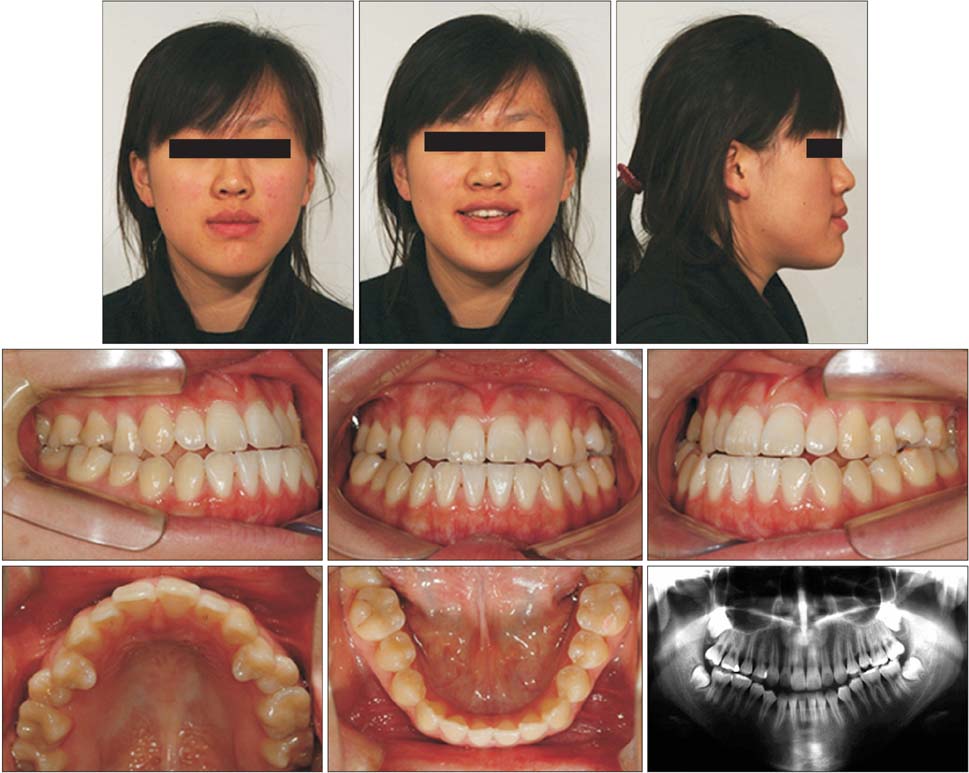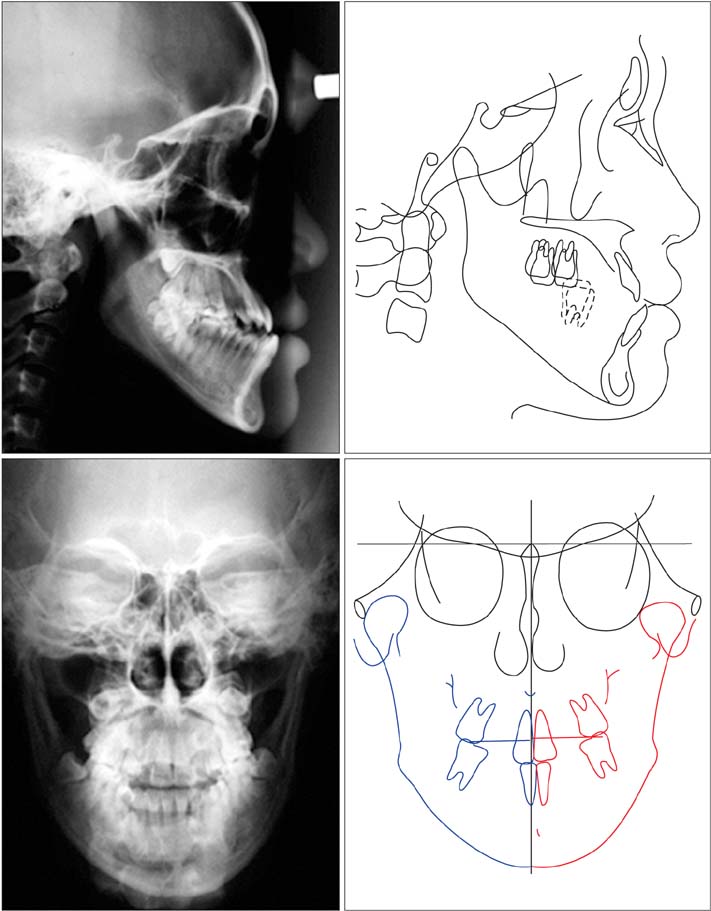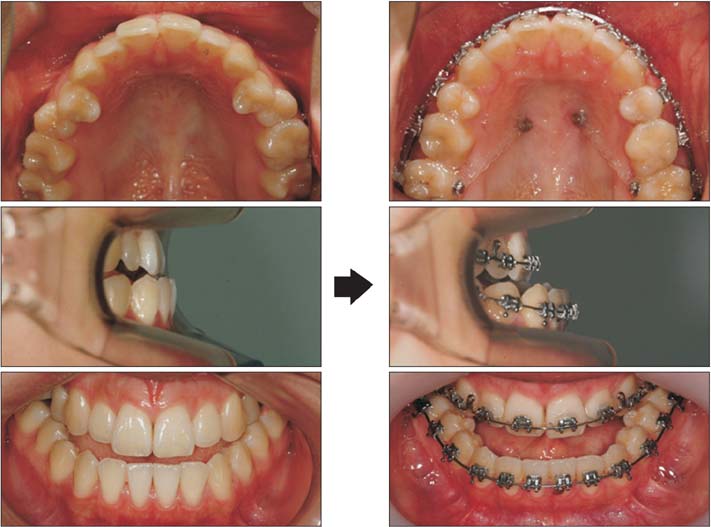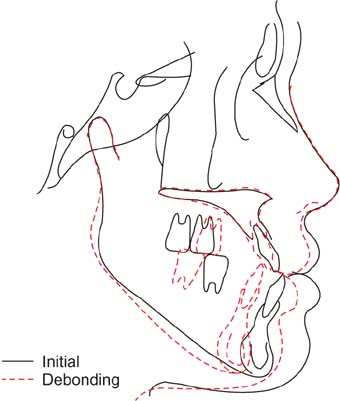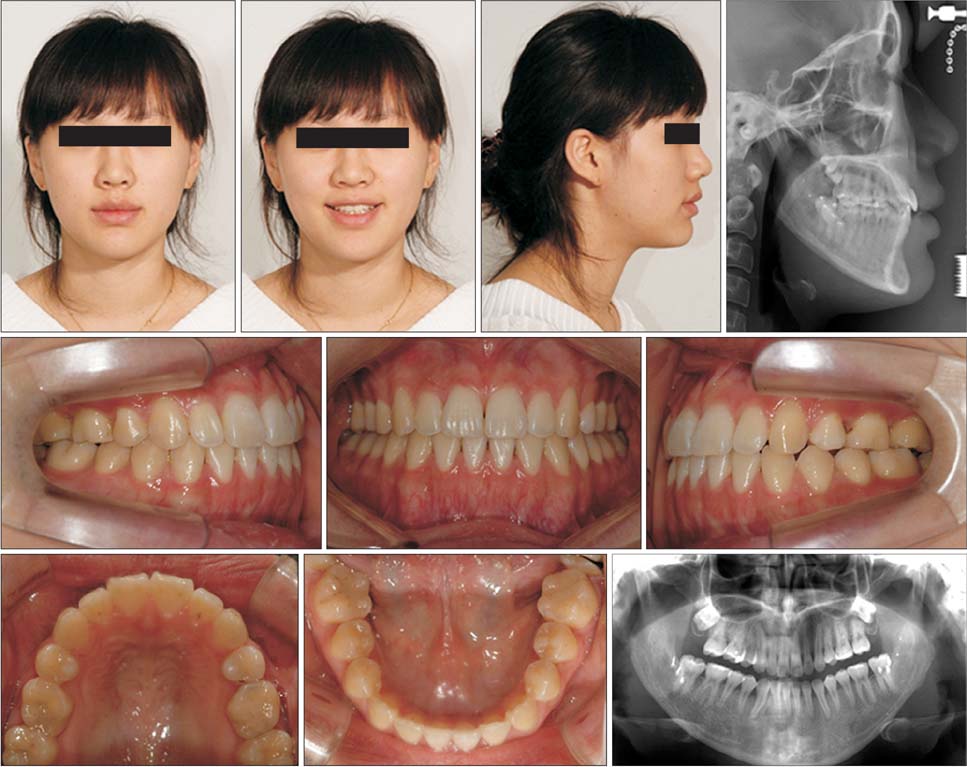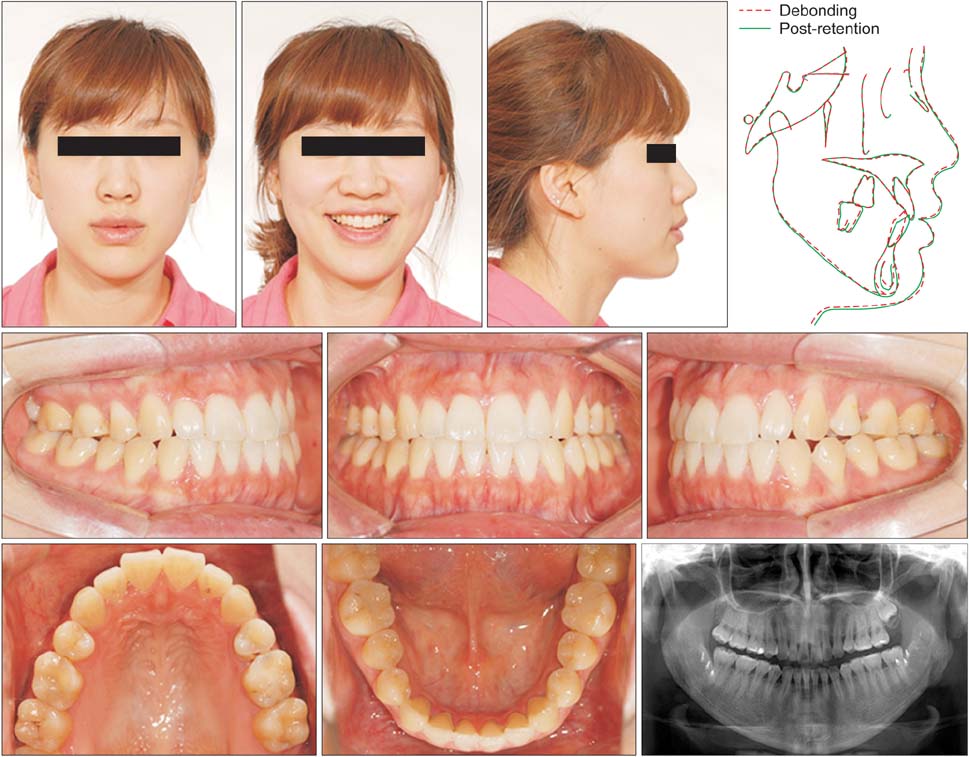Use of mini-implants to avoid maxillary surgery for Class III mandibular prognathic patient: a long-term post-retention case
- Affiliations
-
- 1Department of Orthodontics, Seoul National University School of Dentistry and Dental Research Institute, Seoul, Korea. nonext@snu.ac.kr
- 2Private Practice, Seoul, Korea.
- 3Department of Plastic Surgery, Seoul National University College of Medicine, Seoul, Korea.
- KMID: 2273234
- DOI: http://doi.org/10.4041/kjod.2014.44.6.342
Abstract
- Because of the potential morbidity and complications associated with surgical procedures, limiting the extent of orthognathic surgery is a desire for many orthodontic patients. An eighteen-year-old woman had a severe Class III malocclusion and required bi-maxillary surgery. By changing the patient's maxillary occlusal plane using orthodontic mini-implants, she was able to avoid the maxillary surgery; requiring only a mandibular setback surgery. To accurately predict the post-surgery outcome, we applied a new soft tissue prediction method. We were able to follow and report the long-term result of her combined orthodontic and orthognathic treatment. The changes to her occlusal plane continue to appear stable over 6 years later.
Figure
Cited by 4 articles
-
Treatment effects of mandibular total arch distalization using a ramal plate
Jonghan Yu, Jae Hyun Park, Mohamed Bayome, Sungkon Kim, Yoon-Ah Kook, Yoonji Kim, Chang-Hyen Kim
Korean J Orthod. 2016;46(4):212-219. doi: 10.4041/kjod.2016.46.4.212.Time series analysis of patients seeking orthodontic treatment at Seoul National University Dental Hospital over the past decade
Hyun-Woo Lim, Ji-Hoon Park, Hyun-Hee Park, Shin-Jae Lee
Korean J Orthod. 2017;47(5):298-305. doi: 10.4041/kjod.2017.47.5.298.Evaluation of the stability of maxillary expansion using cone-beam computed tomography after segmental Le Fort I osteotomy in adult patients with skeletal Class III malocclusion
Hoon Kim, Kyung-Suk Cha
Korean J Orthod. 2018;48(1):63-70. doi: 10.4041/kjod.2018.48.1.63.Analysis of time to failure of orthodontic mini-implants after insertion or loading
Jong-Wha Jeong, Jong-Wan Kim, Nam-Ki Lee, Young-Kyun Kim, Jong-Ho Lee, Tae-Woo Kim
J Korean Assoc Oral Maxillofac Surg. 2015;41(5):240-245. doi: 10.5125/jkaoms.2015.41.5.240.
Reference
-
1. Lee SJ, Kim TW, Nahm DS. Transverse implications of maxillary premolar extraction in Class III presurgical orthodontic treatment. Am J Orthod Dentofacial Orthop. 2006; 129:740–748.
Article2. Lee SJ, Lin L, Kim SH, Chung KR, Donatelli RE. Survival analysis of a miniplate and tube device designed to provide skeletal anchorage. Am J Orthod Dentofacial Orthop. 2013; 144:349–356.
Article3. Lee SJ, Ahn SJ, Lee JW, Kim SH, Kim TW. Survival analysis of orthodontic mini-implants. Am J Orthod Dentofacial Orthop. 2010; 137:194–199.
Article4. Yao CC, Lee JJ, Chen HY, Chang ZC, Chang HF, Chen YJ. Maxillary molar intrusion with fixed appliances and mini-implant anchorage studied in three dimensions. Angle Orthod. 2005; 75:754–760.5. Park YC, Lee SY, Kim DH, Jee SH. Intrusion of posterior teeth using mini-screw implants. Am J Orthod Dentofacial Orthop. 2003; 123:690–694.
Article6. Deguchi T, Takano-Yamamoto T, Kanomi R, Hartsfield JK Jr, Roberts WE, Garetto LP. The use of small titanium screws for orthodontic anchorage. J Dent Res. 2003; 82:377–381.
Article7. Choi HJ, Kim TW, Ahn SJ, Lee SJ, Donatelli RE. The relationship between temporomandibular joint disk displacement and mandibular asymmetry in skeletal Class III patients. Angle Orthod. 2011; 81:624–631.
Article8. Jung MH. Age, extraction rate and jaw surgery rate in Korean orthodontic clinics and small dental hospitals. Korean J Orthod. 2012; 42:80–86.
Article9. Yoon KS, Lee HJ, Lee SJ, Donatelli RE. Testing a better method of predicting postsurgery soft tissue response in Class II patients: A prospective study and validity assessment. Angle Orthod. 2014; doi: 10.2319/052514-370.1. [Epub ahead of print].
Article10. Bailey LJ, Cevidanes LH, Proffit WR. Stability and predictability of orthognathic surgery. Am J Orthod Dentofacial Orthop. 2004; 126:273–277.
Article11. Park YC, Lee HA, Choi NC, Kim DH. Open bite correction by intrusion of posterior teeth with miniscrews. Angle Orthod. 2008; 78:699–710.
Article12. Lee SJ, Jang SY, Chun YS, Lim WH. Three-dimensional analysis of tooth movement after intrusion of a supraerupted molar using a mini-implant with partial-fixed orthodontic appliances. Angle Orthod. 2013; 83:274–279.
Article13. Moon SH, Park SH, Lim WH, Chun YS. Palatal bone density in adult subjects: implications for mini-implant placement. Angle Orthod. 2010; 80:137–144.
Article14. Kang S, Lee SJ, Ahn SJ, Heo MS, Kim TW. Bone thickness of the palate for orthodontic mini-implant anchorage in adults. Am J Orthod Dentofacial Orthop. 2007; 131:4 Suppl. S74–S81.
Article15. Lee HJ, Suh HY, Lee YS, Lee SJ, Donatelli RE, Dolce C, et al. A better statistical method of predicting postsurgery soft tissue response in Class II patients. Angle Orthod. 2014; 84:322–328.
Article16. Donatelli RE, Lee SJ. How to report reliability in orthodontic research: Part 2. Am J Orthod Dentofacial Orthop. 2013; 144:315–318.
Article17. Suh HY, Lee SJ, Lee YS, Donatelli RE, Wheeler TT, Kim SH, et al. A more accurate method of predicting soft tissue changes after mandibular setback surgery. J Oral Maxillofac Surg. 2012; 70:e553–e562.
Article18. Lee YS, Suh HY, Lee SJ, Donatelli RE. More accurate soft-tissue prediction model for Class III 2-jaw surgeries. Am J Orthod Dentofacial Orthop. 2014; 146:724–733.19. Jeon H, Lee SJ, Kim TW, Donatelli RE. Three-dimensional analysis of lip and perioral soft tissue changes after debonding of labial brackets. Orthod Craniofac Res. 2013; 16:65–74.
Article20. Han JJ, Yang HJ, Lee SJ, Hwang SJ. Relapse after SSRO for mandibular setback movement in relation to the amount of mandibular setback and intraoperative clockwise rotation of the proximal segment. J Craniomaxillofac Surg. 2014; 42:811–815.
Article
- Full Text Links
- Actions
-
Cited
- CITED
-
- Close
- Share
- Similar articles
-
- Surgical orthodontic treatment of skeletal Class III malocclusion using mini-implant: correction of horizontal and vertical dental compensation
- Interdisciplinary treatment of Class III malocclusion using mini-implant: problem-oriented orthodontic treatment
- A study on the second molar which was malpositioned after orthodontic treatment
- Maxillary protraction using skeletal anchorage and intermaxillary elastics in Skeletal Class III patients
- Maxillary protraction using customized mini-plates for anchorage in an adolescent girl with skeletal Class III malocclusion

